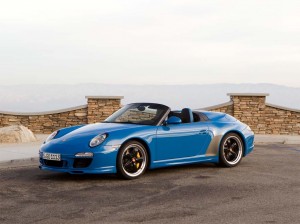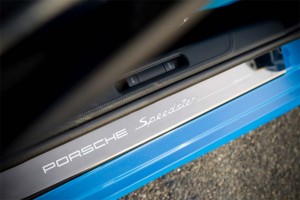One of the more storied models in the history of an iconic company recently made its return, the Porsche Speedster taking its bows at the Paris Motor Show. While purists might insist the new, 911-based model has little in common with the original 356 Speedster of 1954, it’s generated plenty of buzz – and had us eager to get out to Los Angeles when an invitation landed in our e-mail box offering a chance to take the new 2-seater for a drive.
Porsche first introduced a Speedster in 1954. It was based on the 356 model and made it to production – and to the North American market — late that year, after heavy pressure from Max Hoffman, the original Porsche importer in the U.S. Hoffman wanted Porsche to a build cheaper version of the 356 cabriolet, since he was convinced it would be a hit, especially in Southern California.
And, indeed it was, with a peak production of nearly 1200 units in 1957 – and a cadre of fans that included James Dean, the aspiring racer who acted on the side to help feed his need for speed.
The original 356 Speedster had a simple four-cylinder engine, a lightweight body and a lower windshield that could be removed for club racing.
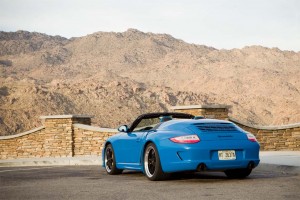
Only 356 of the 2011 Porsche 911 Speedsters will be built, commemorating the original, 356-based model.
The launch of the 2011 Speedster celebrates the upcoming 25th anniversary of Porsche Exclusive, the brand-within-a-brand that offers cars customized to practically any wish of the customer, within, of course, basic technical, quality – and legal — limits.
(Exclusive originated in 1986, when Mansour Ojjeh, the Arab owner of TAG, wanted to have a very special 911. He was Porsche’s partner in the construction of the TAG turbo engine for the McLaren F1 that won two world championships, with Lauda, in 1984, and again with Prost, in 1987.
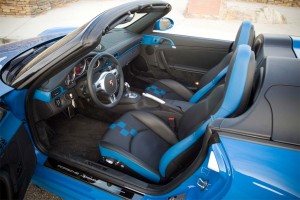
The 2011 Speedster features a lowered windshield and roof -- the manually-operated top expected to stay packed away most of the time.
(The engineers in Zuffenhausen created a unique turbo car with 409 hp, 15-inch wheels — considered gigantic at that time — a large rear wing, and an interior with Connolly leather and wood trim. Ojjeh’s 911, accelerated from 0-62 mph in 4.9 seconds and reached a top of 186 mph – both steallar numbers at the time – and cost half a million German Marks.)
Porsche Exclusive oversaw the development of the limited edition 911 Speedster, honoring the original by limiting production of the new model to just 356. North America will get 100 of them, while my own country, The Netherlands will land just ten – which apparently have already found new owners who are shelling out $204,000 – and still will have to wait until early next year for their cars to arrive.
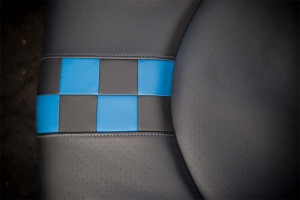
The rich blue body color is carried over into the interior, including the checkerboard seat pattern.
The 2011 Speedster has a 66 mm lower windshield than the 911 Carrera S, consequently lowering the roof some 40 mm. This roof is uninsulated and only meant to be put up when the weather gets bad. But remember: it never rains in California…
Two rollbars are hidden between the bucket seats and the double bubble deck lid. They pop out automatically when a flip seems inevitable. The soft cloth roof and the deck lid have to be put in place by hand. This is one of the measures taken to keep weight down to 1540 kg, or 3395 lbs, although Porsche did not opt for composites or other super-lightweight materials other than for the PCCB ceramic brake disks
Technically the 911 Speedster is identical to the GTS and has the same 3.8-liter flat six-cylinder engine making 408 horsepower. That’s 23 hp more than the Carrera S. The Speedster reaches a top speed of 190 mph and sprints to 60 mph in just 4.2 seconds. The tweaked engine has a notably better speed range than the Carrera S engine, by developing maximum output at 7,300 rpm.
What you immediately feel, when driving, is the higher torque between 3,000 and 4,000 rpm. The Porsche Speedster makes maximum torque of 420 Nm at 4,200 RPMs instead of the 4,400 of the S engine.
Compared to the S, the Speedster’s suspension is nearly an inch lower, while the body is taken from the all-wheel-drive model with a wider rear end, providing space for a wider track. That helps enhance the connected feel you get with the asphalt – something enhanced by the Speedster’s adaptive dampers. Those PCCB ceramic brakes and a limited slip differential are standard.
The engine can only be combined with the 7-speed PDK transmission with double clutch, which can be readily operated manually from the paddles on the steering wheel. It works amazingly well, and adapts to the driver’s mood. When you cruise or want to save gas, the transmission intuitively shifts in the optimal, fuel efficient way. When in Super Sport mode, you aggressively push and lift the throttle or the brake, the transmission rewarding you by shifting in the most sporty and rapid manner possible.
I love the bucket seats and the Pure Blue color that carries over for interior accents. The Speedster that was shipped to Palm Springs for the driving event was the very first one produced: it has a plaque on the dashboard at the passenger side that says 000/356.
As that might suggest, it will be earmarked for Porsche’s own collection, rather than an individual owner. If past is prologue, the 2011 Porsche Speedster will almost certainly become an instant collectible.

